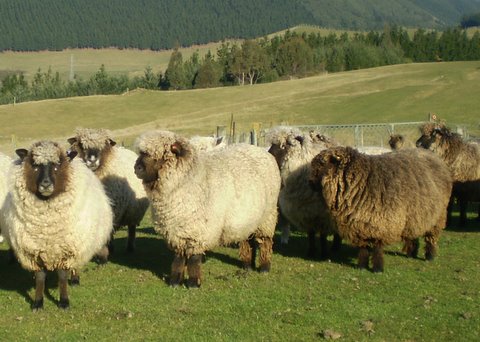Fleecewood Farm
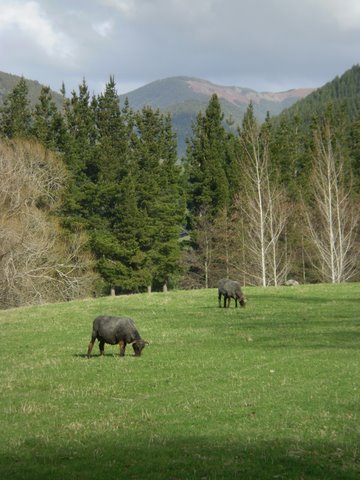 At Fleecewood, we primarily farm sheep to produce wool for handcraft use. The farm is a sunny and secluded 30 Ha (75 acres) of rolling hill country in inland Nelson, New Zealand. It averages 300 m (1000 feet) above sealevel, and has a temperate climate. The sheep live outside year round and thrive on it!
At Fleecewood, we primarily farm sheep to produce wool for handcraft use. The farm is a sunny and secluded 30 Ha (75 acres) of rolling hill country in inland Nelson, New Zealand. It averages 300 m (1000 feet) above sealevel, and has a temperate climate. The sheep live outside year round and thrive on it!
Over the last 25 years we’ve cleared scrub and planted a wide selection of amentity trees to enhance the natural environment and create shelter for the animals. There is an ongoing programme to establish woodlots for timber, with a very successful first rotation harvest of pines in 2011.
We have a large, spray-free vegetable garden and orchard, and a beekeeper manages about 20 hives on the property. We are not an organic farm, but do aim to minimise chemical inputs and manage the property in a sustainable manner, while maintaining a high standard of animal welfare. Over the years an increasing diversity of birdlife has chosen to share the property with us, including many native species.
The Fleecewood Flock
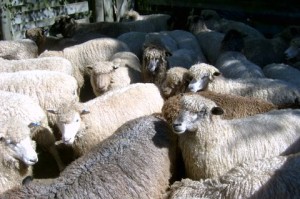 The Fleecewood flock has been developed over the last 20 years by selective breeding of English Leicester and New Zealand Halfbred breeds to produce the unique Fleecewood Leicester sheep. These sheep have long, lustrous wool, with a soft, silky handle, ideal for garments and appreciated for its versitility and ease of spinning. Other breed types in the current flock include: Polworth, and Gotland, Perendale and Romney crosses.
The Fleecewood flock has been developed over the last 20 years by selective breeding of English Leicester and New Zealand Halfbred breeds to produce the unique Fleecewood Leicester sheep. These sheep have long, lustrous wool, with a soft, silky handle, ideal for garments and appreciated for its versitility and ease of spinning. Other breed types in the current flock include: Polworth, and Gotland, Perendale and Romney crosses.
Our sheep range in colour from white to greys, natural black, oatmeal and rich honey browns. Some have distinct spots, while others are a more even colour, or have reverse mouflon colouring (dark backline, face and legs with paler sides).
Breed information and wool characteristics
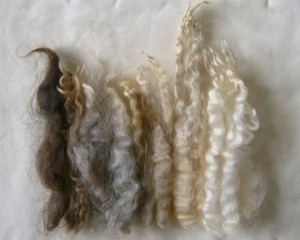 English Leicester
English Leicester
Developed in England during the 18th century, this breed produces large, long-legged animals with a highly lustrous, coarser fibre that forms flat open fleece locks. Annual growth is in excess of 150 mm (6 inches). Coarser fleeces are ideal for hard-wearing rugs and furnishings, and for doll’s hair, whereas finer English Leicester fleeces are great for outerwear as well as furnishings.
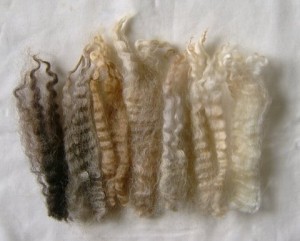 Fleecewood Leicester
Fleecewood Leicester
Developed at Fleecewood farm over the last 20 years, these sheep are a little smaller and finer boned that English Leicester. Their wool combines the length and lustre of English Leicester fleece with the fineness and closer crimp of Halfbred wool. Annual growth is typically 125 – 150 mm (5-6 inches).
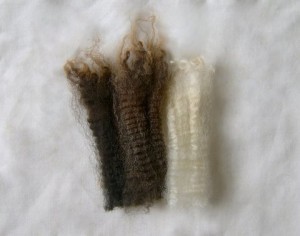 New Zealand Halfbred
New Zealand Halfbred
New Zealand Halfbred sheep are a Merino-Longwool cross, with the longwool breed typically being English Leicester, Lincoln or Romey. Halfbred fleeces typically have 100 –150 mm open staples with a short tip.
Fleecewood Farming Calendar
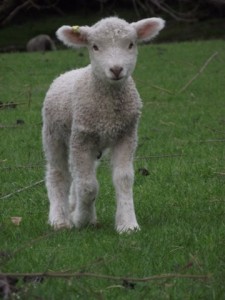 By New Zealand standards, Fleecewood is a small farm, so some of our practices differ from typical methods and schedules used on larger New Zealand sheep farms.
By New Zealand standards, Fleecewood is a small farm, so some of our practices differ from typical methods and schedules used on larger New Zealand sheep farms.
Our schedule revolves around the annual cycle of lambing. However, this really starts back in February, when we start to increase the feed allowance to prepare the ewes for tupping (mating). About 20 March (Autumn), we drench for parasites and crutch (shear around the rear end and remove any dirty or stained wool). We then divide the ewe flock into five separate groups according to fleece type, and put out the appropriate ram with each mob. The rams are left with their mob of ewes for 9 –10 weeks (3 cycles), by which time it is around the end of May.
At this point, the rams are removed from the ewe mobs. The ewes are combined into a single group, and the rams go back to the wether mob. Feed is reduced to a maintenance level, and all sheep are checked for any health and fleece issues. We try to keep the sheep on pasture at this time, using tree fodder if necessary, to avoid having to feed out hay, in order to avoid the hay contamination in long fleece.
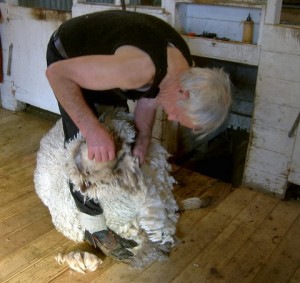 Annual shearing is timed for the second week in July (Winter), but exact timing can vary because we need 2-3 days of fine weather prior to shearing to ensure the full fleeces are dry. Shearing itself takes 1-2 days. All sheep are combined into one mob and walked 2 km to the neighbour’s woolshed. They are sorted into smaller mobs for actual shearing according to gender, age and wool colour. Because of the high degree of care taken with skirting Fleecewood fleeces, the wool handler cannot keep up with the pace of the shearer, so each fleece is loosely laid out in a large wool pack (fadge), and separated from other fleeces by a layer of newspaper. Fleeces are skirted later, and it is not uncommon to spend 30 minutes skirting each fleece.
Annual shearing is timed for the second week in July (Winter), but exact timing can vary because we need 2-3 days of fine weather prior to shearing to ensure the full fleeces are dry. Shearing itself takes 1-2 days. All sheep are combined into one mob and walked 2 km to the neighbour’s woolshed. They are sorted into smaller mobs for actual shearing according to gender, age and wool colour. Because of the high degree of care taken with skirting Fleecewood fleeces, the wool handler cannot keep up with the pace of the shearer, so each fleece is loosely laid out in a large wool pack (fadge), and separated from other fleeces by a layer of newspaper. Fleeces are skirted later, and it is not uncommon to spend 30 minutes skirting each fleece.
After shearing, the sheep are divided into their separate mobs again. It is now about six weeks until lambing starts, and the ewes have an increasing feed allowance, including saved pasture and lucerne hay. About 10 days before lambing starts, ewes are drenched and vaccinated against a range of diseases. This timing ensures disease protection is also transferred to the lamb at birth through the colostrum (first milk).
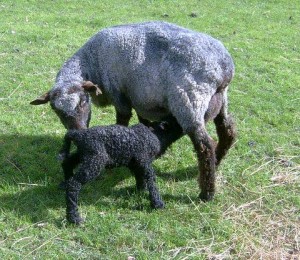 Once lambing starts, around the third week of August, we are kept very busy with checking ewes and lambs at least twice a day. Most lambs are born without any difficulties, but we are on hand to act as midwife if needed. We also put a small tag in the ear of each lamb, and a rubber ring on their tail. The tag ensures we know how to deal with mismothered and lost lambs, and identifies the animal for life. The tail ring causes the tail to drop off after about 3 weeks, reducing dags and the likelihood of flystrike later on. Every few days, lambs and their mothers are separated from the pregnant ewes. Ewes with twins are also separated from those with single lambs, to allow the mothers of twins to be given additional feed. From experience, we have found that most ewes cannot feed three lambs, so we usually remove one triplet and bottle feed them until we can find them an adoptive mother.
Once lambing starts, around the third week of August, we are kept very busy with checking ewes and lambs at least twice a day. Most lambs are born without any difficulties, but we are on hand to act as midwife if needed. We also put a small tag in the ear of each lamb, and a rubber ring on their tail. The tag ensures we know how to deal with mismothered and lost lambs, and identifies the animal for life. The tail ring causes the tail to drop off after about 3 weeks, reducing dags and the likelihood of flystrike later on. Every few days, lambs and their mothers are separated from the pregnant ewes. Ewes with twins are also separated from those with single lambs, to allow the mothers of twins to be given additional feed. From experience, we have found that most ewes cannot feed three lambs, so we usually remove one triplet and bottle feed them until we can find them an adoptive mother.
The lambs are checked at 4 –6 weeks, when most of the male lambs are castrated using a rubber ring. A few exceptional ram lambs are kept as rams for breeding. Lambs are also vaccinated against a range of diseases.
Although lambs can survive on their own from 5 – 6 weeks of age, they are typically kept with their mothers for 3 – 4 months. Lambs are checked, crutched, and receive their follow up vaccine shot at weaning. They are then turned out onto the best feed available to minimise any check in their growth. There is a bit of bleating for a day or so, and then they settle down and get used to living without mother. The ewes are crutched about this time too.
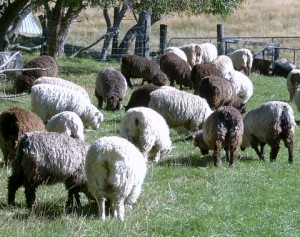 It is usually about this time (early to mid summer) that the fly population starts to explode, and we have to be on the lookout for flystrike. Several varieties of fly like to lay their eggs in warm, moist environments. Sheep’s wool seems to be the ideal location, especially once the fleece is wet from a shower of rain. Some fly species are attracted to manure in the wool, but other species are just as happy with clean wool. So simply crutching animals is not enough. Once maggots hatch, they live in the wool, and if left untreated they will then burrow under the skin of the animal. Eventually, the maggots will cause the animal a protracted and horrible death. So we treat the back and rear of our sheep with an insect growth inhibitor (Magnum) that ensures fly eggs don’t turn into maggots. One application is usually sufficient protection for the season. Occasionally, it is necessary to treat a flystruck animal. We do this by shearing the affected area and applying a dressing (Maggo) to kill any surviving maggots. These fleeces are not offered for sale, and the animal is usually sold later in the season.
It is usually about this time (early to mid summer) that the fly population starts to explode, and we have to be on the lookout for flystrike. Several varieties of fly like to lay their eggs in warm, moist environments. Sheep’s wool seems to be the ideal location, especially once the fleece is wet from a shower of rain. Some fly species are attracted to manure in the wool, but other species are just as happy with clean wool. So simply crutching animals is not enough. Once maggots hatch, they live in the wool, and if left untreated they will then burrow under the skin of the animal. Eventually, the maggots will cause the animal a protracted and horrible death. So we treat the back and rear of our sheep with an insect growth inhibitor (Magnum) that ensures fly eggs don’t turn into maggots. One application is usually sufficient protection for the season. Occasionally, it is necessary to treat a flystruck animal. We do this by shearing the affected area and applying a dressing (Maggo) to kill any surviving maggots. These fleeces are not offered for sale, and the animal is usually sold later in the season.
The ewes and wethers are on maintenance feed over the summer, until three weeks before tupping, when the whole cycle starts again.
As we go into autumn, any lambs marked for selling on will be shorn. The rest are crutched, and drenched for parasites as necessary.
Obviously, we cannot keep all the lambs that are born, only those needed for replacement stock. Thus, we may have sheep of any age and gender available for sale at any time throughout the year. Please contact us if you are interested in purchasing any of our sheep. We welcome enquiries.
Back to top

